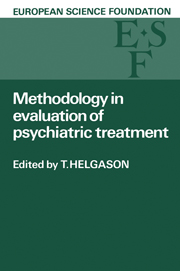 Methodology in Evaluation of Psychiatric Treatment
Methodology in Evaluation of Psychiatric Treatment Book contents
- Frontmatter
- Contents
- Participants
- Foreword
- Preface
- INTRODUCTION
- I METHODS OF CLASSIFICATION
- II EVALUATION CRITERIA
- III RATING METHODS IN EVALUATION OF TREATMENT
- TheAMP Rating Methods
- The Comprehensive Psychopathological Rating Scale (CPRS)
- The Use of Rating Scales for Affective Disorders
- Self-Rating Scales in the Evaluation of Psychiatric Treatment
- Methods for Measuring Social Adjustment
- IV OTHER QUANTITATIVE METHODS OFEVALUATION OF TREATMENT
- V ETHICALAND PRACTICAL PROBLEMS
- Index
The Use of Rating Scales for Affective Disorders
from III - RATING METHODS IN EVALUATION OF TREATMENT
- Frontmatter
- Contents
- Participants
- Foreword
- Preface
- INTRODUCTION
- I METHODS OF CLASSIFICATION
- II EVALUATION CRITERIA
- III RATING METHODS IN EVALUATION OF TREATMENT
- TheAMP Rating Methods
- The Comprehensive Psychopathological Rating Scale (CPRS)
- The Use of Rating Scales for Affective Disorders
- Self-Rating Scales in the Evaluation of Psychiatric Treatment
- Methods for Measuring Social Adjustment
- IV OTHER QUANTITATIVE METHODS OFEVALUATION OF TREATMENT
- V ETHICALAND PRACTICAL PROBLEMS
- Index
Summary
Introduction
The growing tendency to construct new rating scale systems seems not to be based on intensive analyses of their predecessors. This seems especially to be the case in the field of affective disorders (e.g. Snaith 1981). Thereby the effort to obtain international standards for recording clinical data, for example, in the evaluating of psychiatric treatment, has been delayed. This overview is an attempt to reconsider the use of the prevailing rating scales for affective disorders. In this connection it is important to realize that rating scales are more than operational definitions of clinical data at the level of observation. Rating scales contain, moreover, specific criteria by which the various items of the scale can be combined to syndromes or diagnoses.
In this overview most emphasis will be laid on the rules for combination of items. There are two different elements of such combinations, namely (1) quantitative elements, when measuring the severity of affective states, and (2) qualitative elements when measuring the diagnosis of affective illnesses.
Quantitative rating scales for affective states
General considerations
A symptom rating scale is an instrument for measuring the severity of affective states. Therefore, such scales must contain the most characteristic and observable symptoms for measuring states like depression, anxiety or mania.
Traditionally, the rule for combination of the individual symptoms within quantitative scales is the summed scale score or the total score. However, the resistance shown by clinicians toward the use of rating scales exactly reflects their scepticism about the value of summing different symptoms to a total score. This scepticism is, moreover, shared by statisticians, because the scores obtained by rating scales are categorized values, not truly numerical values. In the statistical inference, therefore, statistical models for categorized data should be used, and only when evidence has been obtained by such analyses can the individual item score be combined to a single total score. The quantitative rating scale which has been the object for most analyses is the Hamilton Depression Scale (Hamilton 1960), and our analysis of this scale will focus on the evidence for using a total score as the rating for depressive states.
- Type
- Chapter
- Information
- Methodology in Evaluation of Psychiatric TreatmentProceedings of a Workshop Held in Vienna 10–13 June 1981, pp. 171 - 182Publisher: Cambridge University PressPrint publication year: 1983


